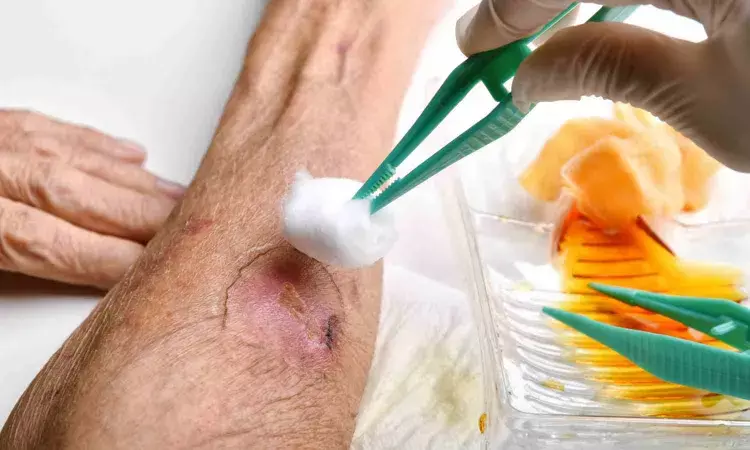- Home
- Medical news & Guidelines
- Anesthesiology
- Cardiology and CTVS
- Critical Care
- Dentistry
- Dermatology
- Diabetes and Endocrinology
- ENT
- Gastroenterology
- Medicine
- Nephrology
- Neurology
- Obstretics-Gynaecology
- Oncology
- Ophthalmology
- Orthopaedics
- Pediatrics-Neonatology
- Psychiatry
- Pulmonology
- Radiology
- Surgery
- Urology
- Laboratory Medicine
- Diet
- Nursing
- Paramedical
- Physiotherapy
- Health news
- Fact Check
- Bone Health Fact Check
- Brain Health Fact Check
- Cancer Related Fact Check
- Child Care Fact Check
- Dental and oral health fact check
- Diabetes and metabolic health fact check
- Diet and Nutrition Fact Check
- Eye and ENT Care Fact Check
- Fitness fact check
- Gut health fact check
- Heart health fact check
- Kidney health fact check
- Medical education fact check
- Men's health fact check
- Respiratory fact check
- Skin and hair care fact check
- Vaccine and Immunization fact check
- Women's health fact check
- AYUSH
- State News
- Andaman and Nicobar Islands
- Andhra Pradesh
- Arunachal Pradesh
- Assam
- Bihar
- Chandigarh
- Chattisgarh
- Dadra and Nagar Haveli
- Daman and Diu
- Delhi
- Goa
- Gujarat
- Haryana
- Himachal Pradesh
- Jammu & Kashmir
- Jharkhand
- Karnataka
- Kerala
- Ladakh
- Lakshadweep
- Madhya Pradesh
- Maharashtra
- Manipur
- Meghalaya
- Mizoram
- Nagaland
- Odisha
- Puducherry
- Punjab
- Rajasthan
- Sikkim
- Tamil Nadu
- Telangana
- Tripura
- Uttar Pradesh
- Uttrakhand
- West Bengal
- Medical Education
- Industry
Smart hydrogel mimics skin repair to accelerate diabetic wound healing, suggests research

Diabetic wounds remain one of the most challenging complications of diabetes, often leading to chronic ulcers, infections, and even amputations. In a groundbreaking development, researchers have engineered a smart hydrogel dressing that replicates the skin’s natural healing process to promote faster and more effective wound closure. The study, published in the Journal of Bioresources and Bioproducts, introduces a composite hydrogel that integrates bacterial cellulose (BC), conductive polypyrrole (PPy), and platelet-rich plasma (PRP) into a single multifunctional platform.
The hydrogel, referred to as PBP (polypyrrole/bacterial cellulose/platelet-rich plasma), is designed to address the key barriers to diabetic wound healing: persistent inflammation, bacterial infection, and poor tissue regeneration. BC provides a porous, biocompatible scaffold that mimics the extracellular matrix, while PRP—rich in growth factors like VEGF, EGF, and PDGF—supports cell proliferation and angiogenesis. PPy, a conductive polymer, not only enhances the hydrogel’s antibacterial properties through capacitive charging but also enables electrically triggered release of growth factors.
In laboratory tests, the charged PBP hydrogel demonstrated over 98% antibacterial efficacy against both E. coli and S. aureus, common pathogens in diabetic wounds. The hydrogel’s electrical stimulation capability further boosted its performance, promoting fibroblast and endothelial cell growth while modulating macrophage polarization from a pro-inflammatory (M1) to a pro-healing (M2) phenotype.
In a diabetic mouse model, wounds treated with the PBP hydrogel—especially when combined with electrical stimulation—showed significantly faster healing. By day 14, nearly complete wound closure was observed, with enhanced collagen deposition, vascularization, and epidermal regeneration. The hydrogel also maintained a moist microenvironment, absorbed exudate, and reduced inflammatory cytokines, all critical for optimal wound repair.
What sets this dressing apart is its ability to mimic the physiological phases of skin repair: inflammation control, tissue formation, and remodeling. Unlike conventional dressings that offer passive protection, the PBP hydrogel actively participates in the healing process. Its electroresponsive nature allows for on-demand drug release, making it a potential platform for personalized wound care.
The researchers emphasize the sustainability and scalability of their approach. BC is derived from bacterial fermentation using renewable feedstocks, PRP is obtained from autologous blood, and PPy is synthesized via low-energy chemical polymerization. While challenges remain in large-scale manufacturing, such as optimizing hydrogel morphology and production efficiency, the team suggests that technologies like pressurized gyration spinning could enable mass production.
This innovative dressing represents a major step forward in chronic wound management. By integrating bioinspired design with smart material functionality, the PBP hydrogel offers a promising, clinically translatable solution for diabetic wound healing. Future work will focus on refining the material’s mechanical properties, extending growth factor release duration, and validating its efficacy in larger animal models and human trials.
Reference: Hao Wang, Pengyu He, Guoliang Tang,Fuyu Qi, Xu Lu, Maoxu Zhang, Ruizhu Zheng, Xiaohong Li, Zhijun Shi, Yaopeng Zhang, Guang Yang, Smart hydrogel mimics skin repair to accelerate diabetic wound healing, Journal: Journal of Bioresources and Bioproducts, DOI 10.1016/j.jobab.2025.10.004
Dr Kamal Kant Kohli-MBBS, DTCD- a chest specialist with more than 30 years of practice and a flair for writing clinical articles, Dr Kamal Kant Kohli joined Medical Dialogues as a Chief Editor of Medical News. Besides writing articles, as an editor, he proofreads and verifies all the medical content published on Medical Dialogues including those coming from journals, studies,medical conferences,guidelines etc. Email: drkohli@medicaldialogues.in. Contact no. 011-43720751


